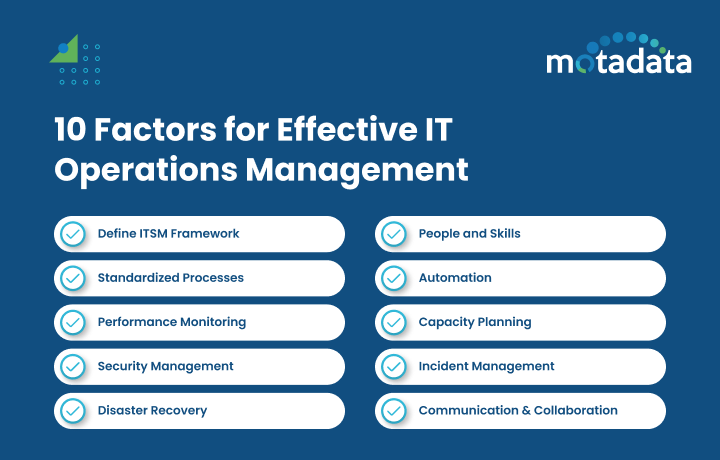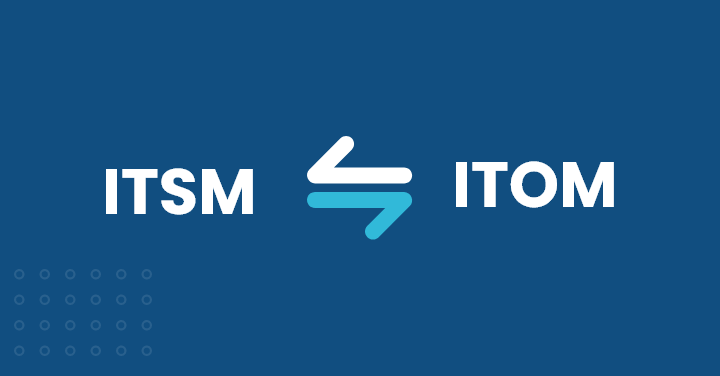In today’s digital age, businesses have become dependent on servers, networks, applications, cloud services, for smooth operations and customer satisfaction.
To ensure that your applications and other IT infrastructure are working seamlessly, it has become crucial to properly manage your IT operations.
Network congestion, server issues, downtime, and application failure are a few conditions that may occur without an effective management system. Hence, it is essential to invest in IT operations management (ITOM) practices.
ITOM practices involve the administration of hardware, software infrastructure, network resources, performance data, and availability of IT infrastructure.
These practices enable IT teams to keep real-time track of IT systems, improve business services, streamline all operations and deployment workflows, reduce errors, and keep the business up-to-date with evolving technology.
It even allows users to track the health status of routers, switches, desktops, laptops, hubs, and other networking components in real-time.
Regardless of your industry, ITOM can help deliver reliable and efficient IT services.
Let us discuss some of the key factors that one must consider to manage IT operations effectively.
10 Factors for Effective IT Operations Management
1. Define IT Service Management (ITSM) Framework:
Unlike other IT disciplines, the ITSM framework focuses on streamlining IT processes and services rather than systems.
Using this framework, ITOM teams can better optimize and develop organizational networks, computing resources, and other service desk operations.
It involves planning, optimization, execution, and management of IT services and processes to meet the demands of both internal as well as external users. Further, it helps identify and mitigate IT service risks.
ITIL framework (Information Technology Infrastructure Library) and COBIT (Control Objectives for Information and Related Technologies) are the two most popular and widely adopted frameworks for ITSM. ITIL ensures that your IT services align with your customer needs. COBIT, on the other hand, offers governance and assurance.
By implementing ITSM solutions, businesses can improve their service quality and user experience.
2. People and Skills:
Another key factor to consider is to ensure you have a team of skilled and qualified people who are capable of achieving business objectives.
Make sure they have enough knowledge, the right skills, and good experience in identifying and resolving technical issues and network errors in real-time.
Also, capable enough to implement robust security measures and integrate new technologies.
With the fast-evolving technology, it is also essential to foster continuous learning and development for IT staff.
With these investments, your IT team will always stay updated on the latest developments and will be able to maintain a more secure IT environment.
Additionally, the regular training sessions will help your team manage several technical challenges faster.
3. Standardized Processes:
With standardized processes, businesses can better streamline their workflows, remove unnecessary tasks, and make more efficient use of resources.
Further, having a consistent and uniform approach helps track if tasks are performed correctly as well as reduces performance issues, thus maintaining better quality control and reliability.
Additionally, it reduces misunderstandings among team members and fosters better communication.
Change management, IT asset management, network incident management and service request management are some of the key examples of ITSM processes.
In Incident management, these processes help handle incidents more effectively. In change management, employees can track all activities as well as risks associated with changes in real-time.
Similarly, it helps in the systematic identification of issues in problem management.
4. Automation:
With automation features, IT organizations can improve their productivity, save on costs, reduce human errors as well as maintain more consistency and accuracy.
There are several benefits to automating routine tasks for operations management. Additionally, with the automation tool, users can keep a regular check on compliance reports, apply for security patches, and monitor vulnerabilities in real time.
ITOM tools use artificial intelligence (AI) and machine learning techniques to automate tasks and even generate insightful reports highlighting system performance status, potential errors, the root cause of the problem, and response time.
In fact, today many businesses are using AIOps methods to evaluate large data volumes, track events and identify their underlying causes.
Ansible, Jenkins, Nagios, and PowerShell are a few popular automation tools and technologies that you can rely on to manage complex workflows and achieve organizational goals.
5. Performance Monitoring:
Monitoring the performance of your servers, applications, networks as well as IT systems is highly crucial for effective IT operations management.
These insights allow IT teams to identify issues at an initial stage and troubleshoot them before they escalate.
Further, you can keep a close watch on resource usage and prevent unnecessary resource consumption as well as save costs.
Another major benefit of continuous performance monitoring is, that you can reduce downtime and ensure better service delivery as well as user experience.
In short, there are several benefits to this factor. Moreover, it is necessary to keep track of CPU usage, Disk I/O, memory consumption, latency, error rate, uptime, and downtime along with bandwidth usage; and an optimal ITSM software can render you all this.
By keeping a constant track of some of these key metrics, you can enhance your operational efficiency and maintain a secure IT infrastructure.
6. Capacity Planning:
Organizations can better allocate resources and meet both current and future demands with capacity planning.
It is another crucial process that is highly essential for organizations for it helps avoid underutilization or overutilization of resources as well as cost optimization.
With proper capacity planning, IT teams can identify the areas that require less or more resources for smooth functioning and fewer system slowdowns or interruptions.
Further, you can identify possible risks related to resource constraints and take preventive actions to lessen them.
For effective capacity planning, all you require is to constantly keep track of current usage trends, ensure you have sufficient resources for backup, and monitor your user feedback continuously.
User feedback tracking helps identify areas where capacity adjustments are highly crucial.
7. Security Management:
We are heavily reliant on servers, networks, and a wide range of services just to be quick and keep our customers happy and satisfied.
But too much dependency on these platforms also poses certain risks. With the rise in cyber threats and malware practices, it is recommended to implement robust IT security measures for data protection and better operations management.
Effective security protocols, strict data policies, and encryption methods will not only keep your data safe but also prevent your business operations from certain disruptions.
Further, it will help maintain your organization’s financial health and stability.
For better security, make sure to run regular vulnerability scans and audits.
Further, ensure that only authorized users have system access to use your critical data or systems via role-based access controls and multi-factor authentications.
You can even encrypt all your data or install patch software to reduce data exploitation.
In addition to this, create regular backups and enforce strict security policies to address emerging threats and risks.
These security measures will not only help reduce MTTR but also ensure that teams can focus on other major tasks.
8. Incident Management:
Another important factor essential for effective IT operations is the handling of IT incidents.
If you have a structured incident management process, i.e., all your incidents are addressed in real-time, chances are high that your downtime will be reduced to a great extent.
Additionally, consistency in responding to customer queries and concerns builds trust among users and leads to more reliable outcomes.
IT teams may easily and swiftly respond to client inquiries with the help of support services.
There are certain key steps that you must follow to better handle the incident management process, such as identification of incidents via automated monitoring systems, record logging for better analysis, proper categorization, root cause analysis, and quick resolution.
Also, detailed reporting for future reference and analysis.
By following these best practices, organizations can ensure that all their IT incidents are being managed effectively and efficiently.
Read Also: Top 9 Incident Management Best Practices
9. Disaster Recovery:
Having a disaster recovery plan is crucial for any organization to ensure business continuity.
With the help of ITOM software, organizations can implement regular data backups and restore processes to their original form in no time.
It not only helps reduce downtime but also ensures that your data remains safe and secure at all times, even in the case of data loss.
Further, having a well-defined disaster recovery plan helps prevent reputational damage, financial losses, and other conditions.
Make sure your disaster recovery plan includes risk assessments and proper analysis of how the identified potential threats can impact your business operations.
Secondly, ensure that all your backup files are stored in a separate location, i.e., off-site or in the cloud to protect from attackers.
Further, make sure to document all the steps of recovery or restoring applications in a proper place so that employees and IT professionals can recover easily and prevent further damage.
By incorporating these practices, organizations can surely survive emergencies and minimize their impact on the business.
10. Communication and Collaboration:
Communication is the key to business success. In the IT industry or any other business department, if there is no to less communication or collaboration, there are fewer chances that you will succeed.
Without proper communication and collaboration, you might face a lot of misunderstandings, human errors, and bad decisions.
However, effective communication helps keep your initiatives and business goals aligned.
Further, proper collaboration between IT teams can improve overall efficiency and reduce redundancies.
It will further improve problem-solving skills and enable employees to get better insights into business needs.
With proper communication, employees can even create a more user-friendly environment that suits their organizational needs.
In short, communication and collaboration can contribute to overall resilience and enhance efficiency.
Conclusion
Operations management involves planning, controlling, and handling all the IT processes for smooth service delivery and customer satisfaction.
Apart from enhancing the productivity level, the ITOM solutions help keep a check on product quality, automate routine tasks to reduce human errors and save costs by monitoring several performance metrics and resources.
Without an ITOM tool, responsibilities like event management, cybersecurity operations, and application performance monitoring are made more difficult.
However, with its implementation, you can gain more visibility into your operations, track outages in real-time, send alerts notifying about potential issues and more.
Implementation of the ITSM platform, automation functionalities, capacity planning, application performance monitoring, adaptation of strict security measures, incident management, user account management, disaster recovery, and ensuring skilled employees are some of the key factors that contribute to effective IT operations management.
These practices together help achieve business goals and ensure the security of IT systems. Without these factors, you might face downtime, data breaches, and other issues.
For more unique solutions or insights on ITOM platforms that can help accelerate your business growth, feel free to contact us.
Adopt a proactive approach that will help you improve productivity, security, and efficiency.








